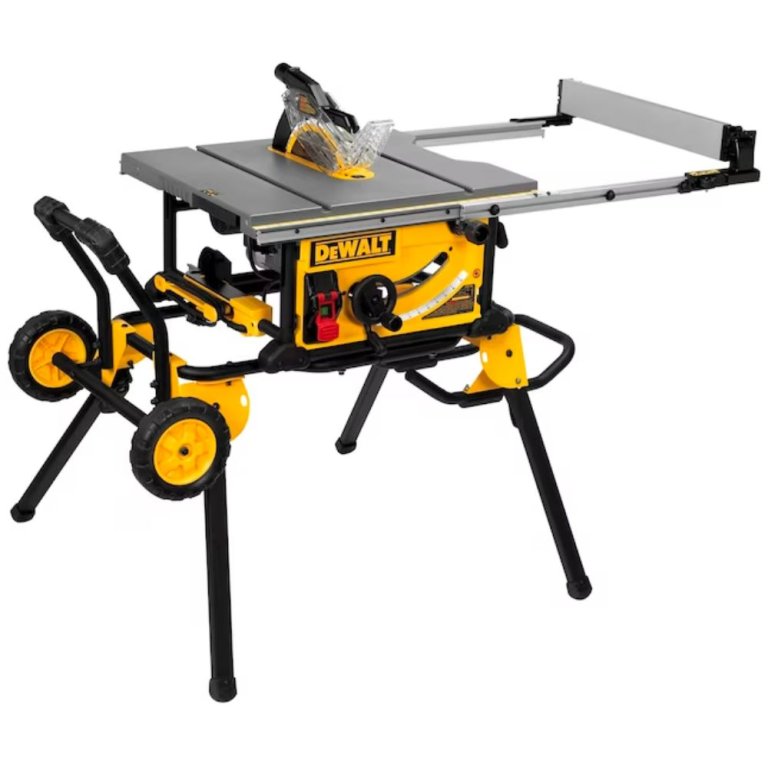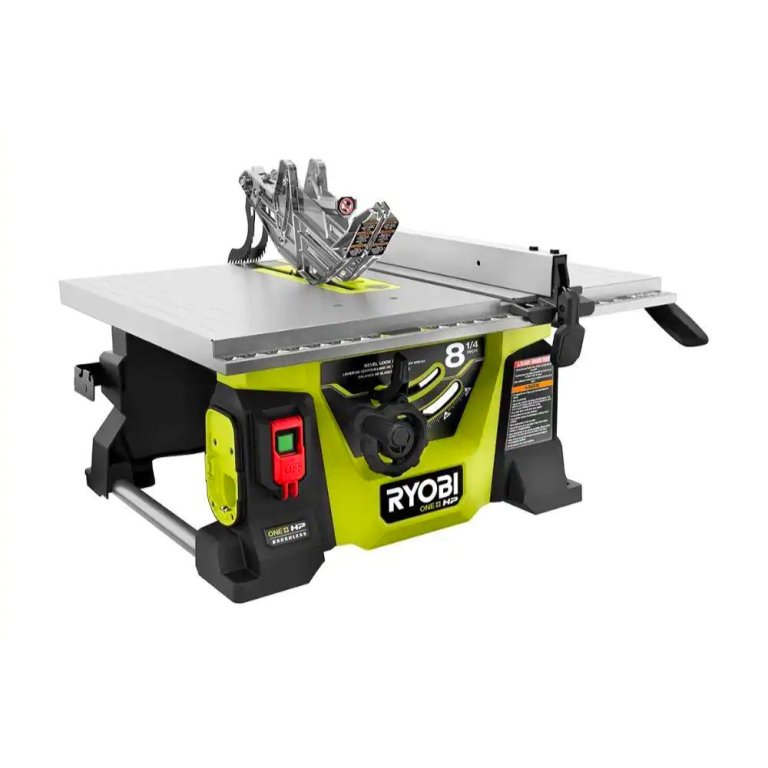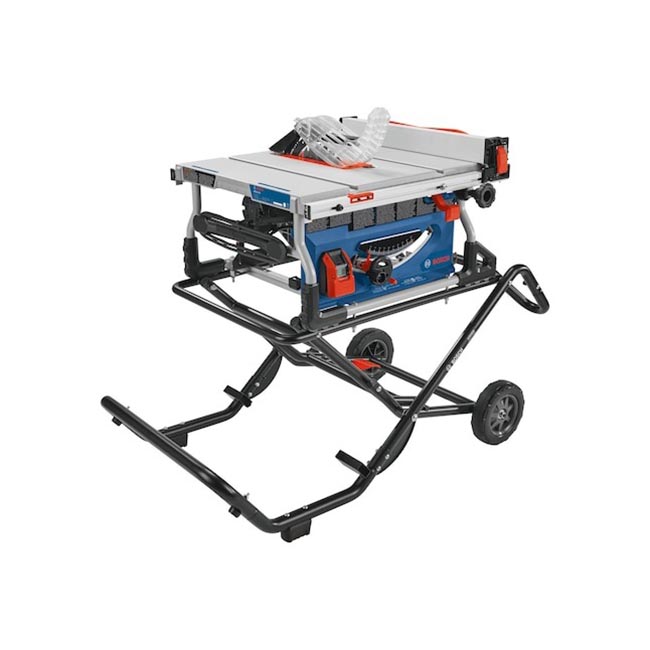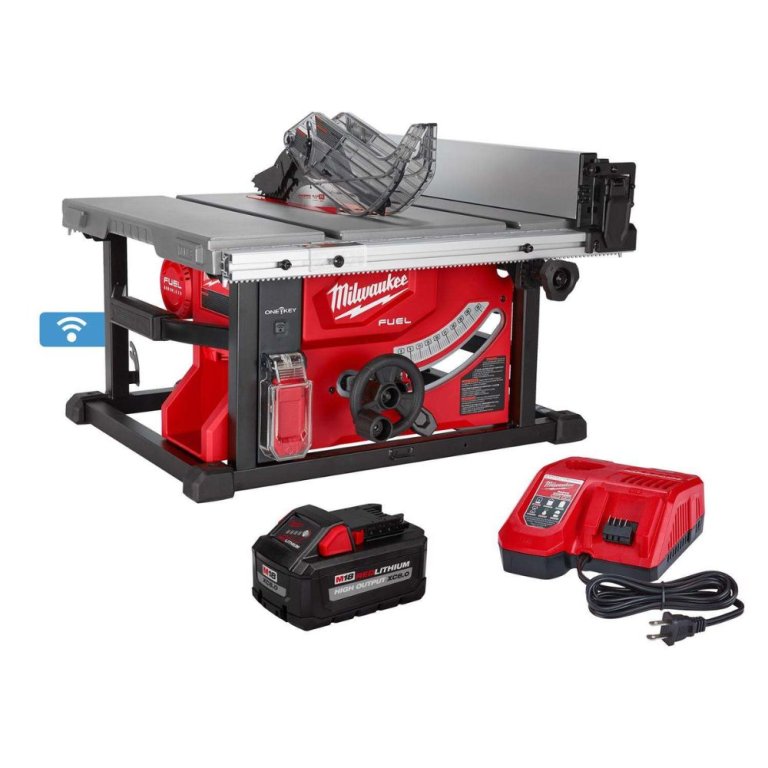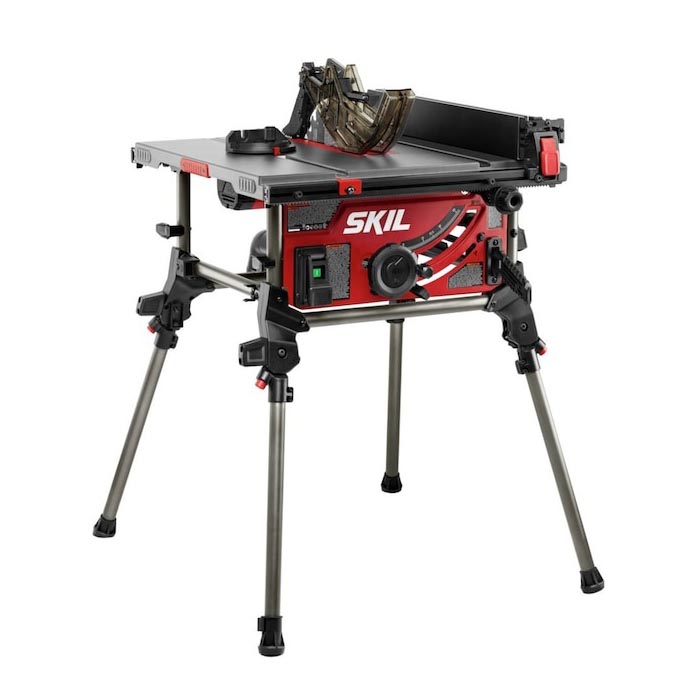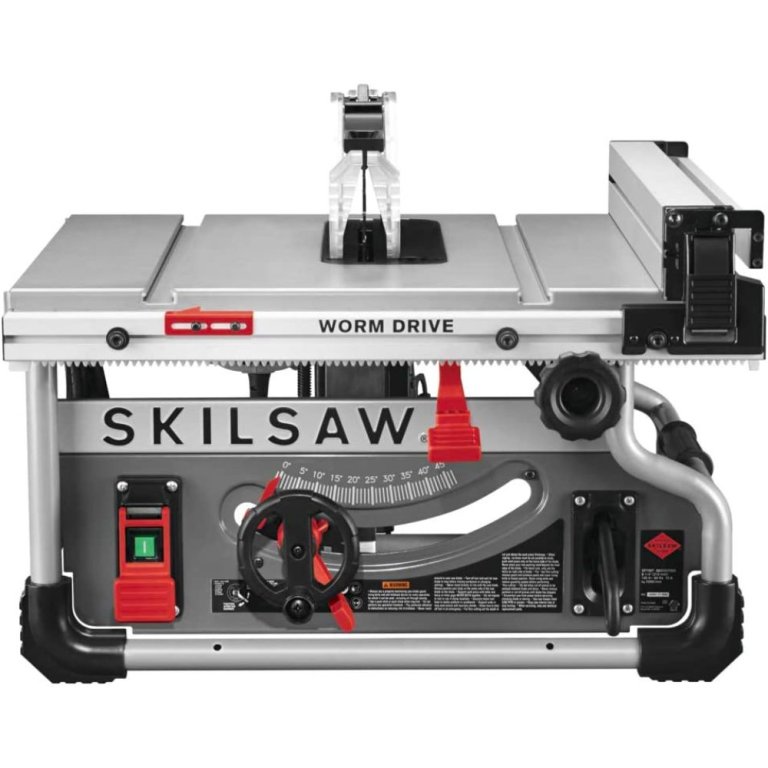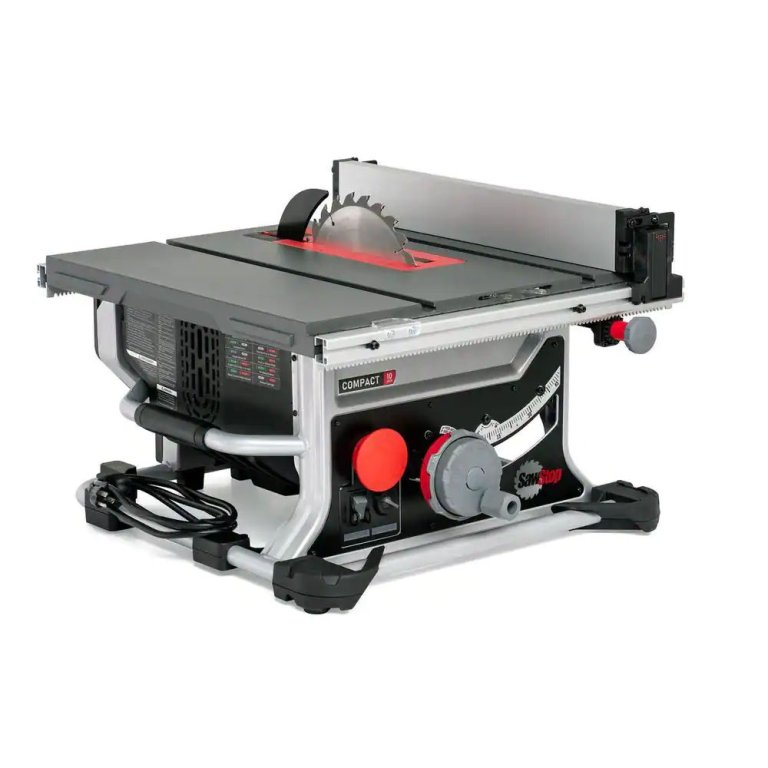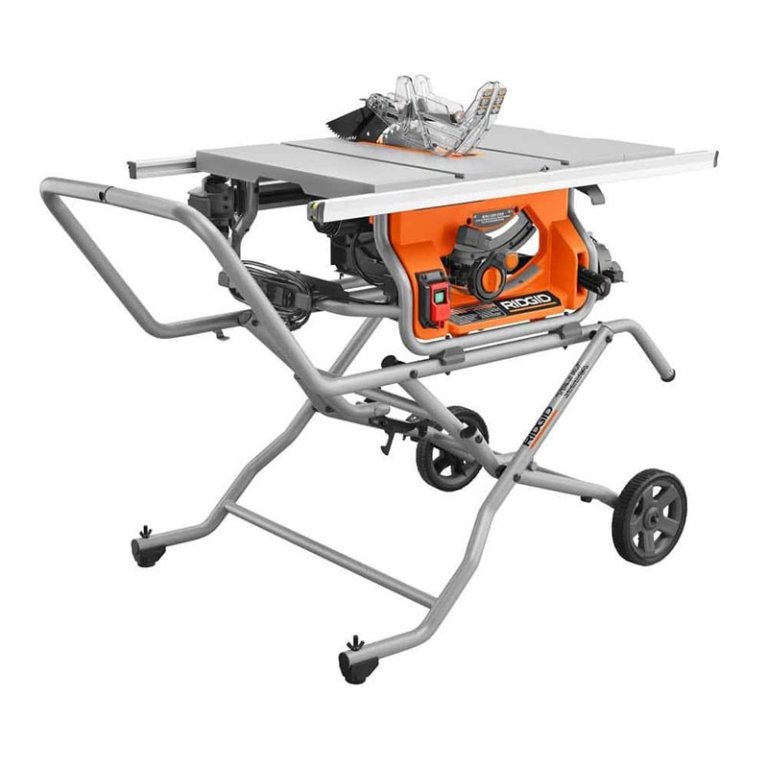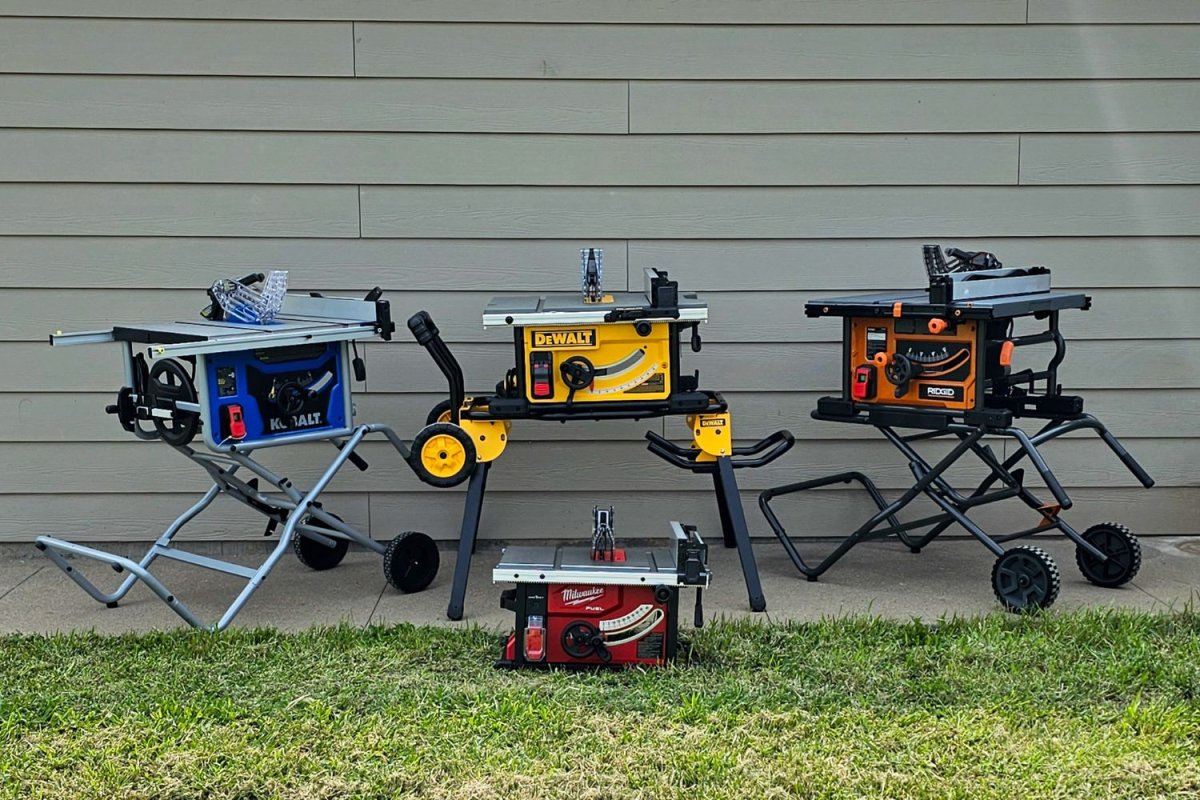
We may earn revenue from the products available on this page and participate in affiliate programs. Learn More ›
Table saws top the wish lists of both DIYers and seasoned woodworkers. After researching more than 25 popular models, we put some of the best table saws through side-by-side hands-on testing.
These powerful tools cut with more accuracy than circular saws, and they can cut larger pieces of material, including wood, plastic, and aluminum sheeting. Essentially, a table saw’s main function is to perform rips, or cuts along the length of a board. While you can make rip cuts (lengthwise cuts), crosscuts, and angled cuts, and can even create a bevel cut along with dadoes, ripping remains this power tool’s primary purpose.
From simple DIY tasks to a months-long setup for remodeling a house, we put these table saws through a range of real-life uses so we could share our experience. After testing, our favorite was the DeWalt 10-Inch Jobsite Table Saw and Rolling Stand for its superior precision and portability.
In this guide, we’ll dive into what makes this type of saw so useful, review our top picks, and outline what to look for when shopping for the best table saw for your workshop.
- BEST OVERALL: DeWalt 10-Inch Jobsite Table Saw and Rolling Stand
↓ Jump to Review - BEST BANG FOR THE BUCK: Ryobi 18V ONE+ HP Brushless 8¼-Inch Table Saw
↓ Jump to Review - UPGRADE PICK: Bosch 10-Inch Worksite Table Saw w/ Wheeled Stand
↓ Jump to Review - BEST CORDLESS: Milwaukee M18 Fuel 8¼-Inch Table Saw w/ One-Key Kit
↓ Jump to Review - BEST FOR HOME WORKSHOP: Skil 10-Inch Jobsite Table Saw
↓ Jump to Review - BEST COMPACT: Skil 8¼-Inch Portable Worm Drive Table Saw
↓ Jump to Review - BEST SAFETY STOP: SawStop Compact Table Saw
↓ Jump to Review - BEST PORTABLE: Ridgid 10-Inch Portable Corded Pro Jobsite Table Saw
↓ Jump to Review - BEST RIP CAPACITY: Metabo HPT 10-Inch Table Saw With Fold and Roll Stand
↓ Jump to Review
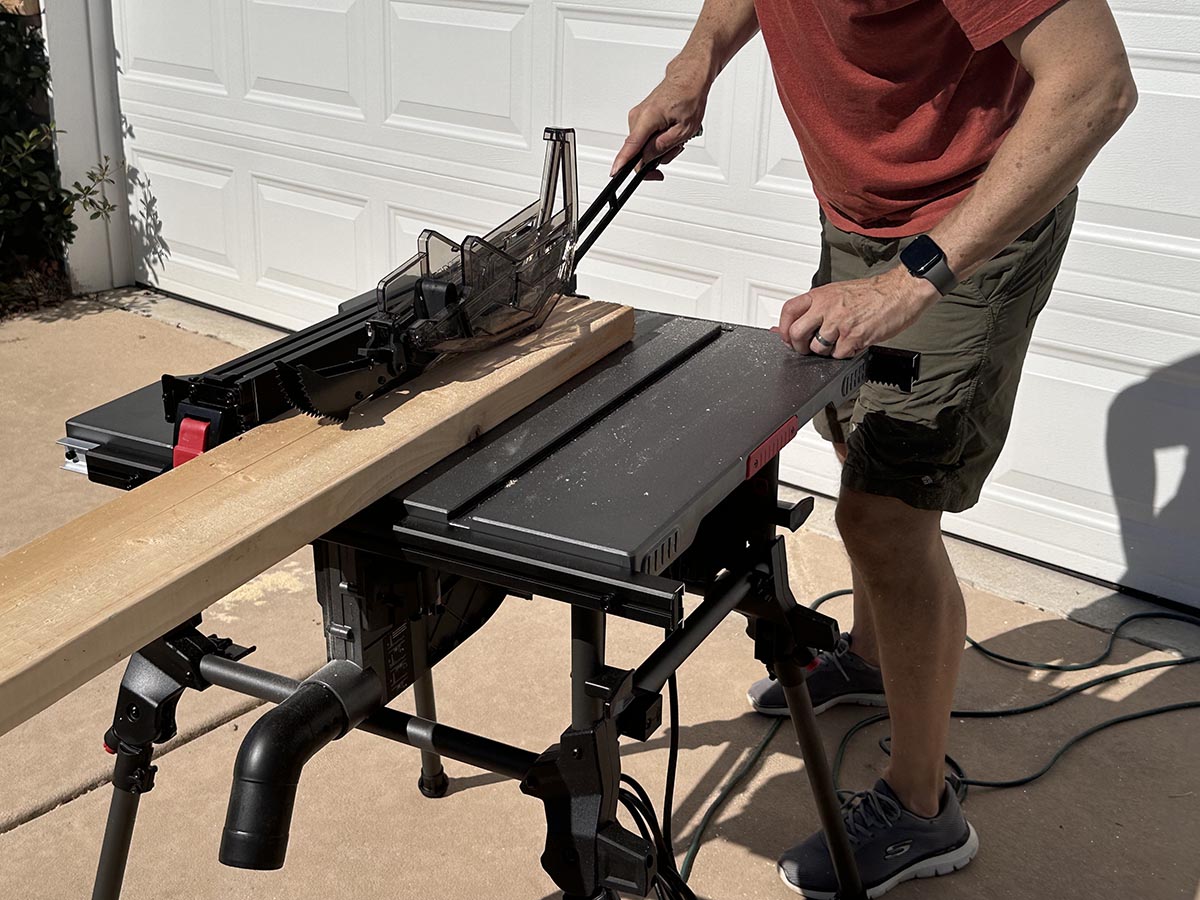
| Type | Blade Size | Cutting Depth | Rip capacity | Weight | |
| DeWalt 10-Inch Jobsite Table Saw and Rolling Stand | Benchtop | 10 inches | 3.125 inches | 32.5 inches | 90 pounds |
| Ryobi 18V ONE+ HP Brushless 8¼-Inch Table Saw | Benchtop | 8.25 inches | 2.25 inches | 12 inches | 32.8 pounds |
| Bosch 10-Inch Worksite Table Saw w/ Wheeled Stand | Contractor | 10 inches | 3.56 inches | 32.125 inches | 91 pounds |
| Milwaukee M18 Fuel 8¼-Inch Table Saw w/ One-Key Kit | Bench | 8.25 inches | 2.5 inches | 24.5 inches | 41.6 pounds |
| Skil 10-Inch Jobsite Table Saw | Bench | 10 inches | 3.5 inches | 25.5 inches | 51.2 pounds |
| Skil 8¼-Inch Portable Worm Drive Table Saw | Benchtop | 8.25 inches | 2.625 inches | 25 inches | 44 pounds |
| SawStop Compact Table Saw | Bench-type | 10 inches | 3.125 inches | 24.5 inches | 68 pounds |
| Ridgid 10-Inch Portable Corded Pro Jobsite Table Saw | Contractor | 10 inches | 3.5 inches | 30 inches | 95 pounds |
| Metabo HPT 10-Inch Table Saw With Fold and Roll Stand | Contractor | 10 inches | 3.125 inches | 35 inches | 96 pounds |
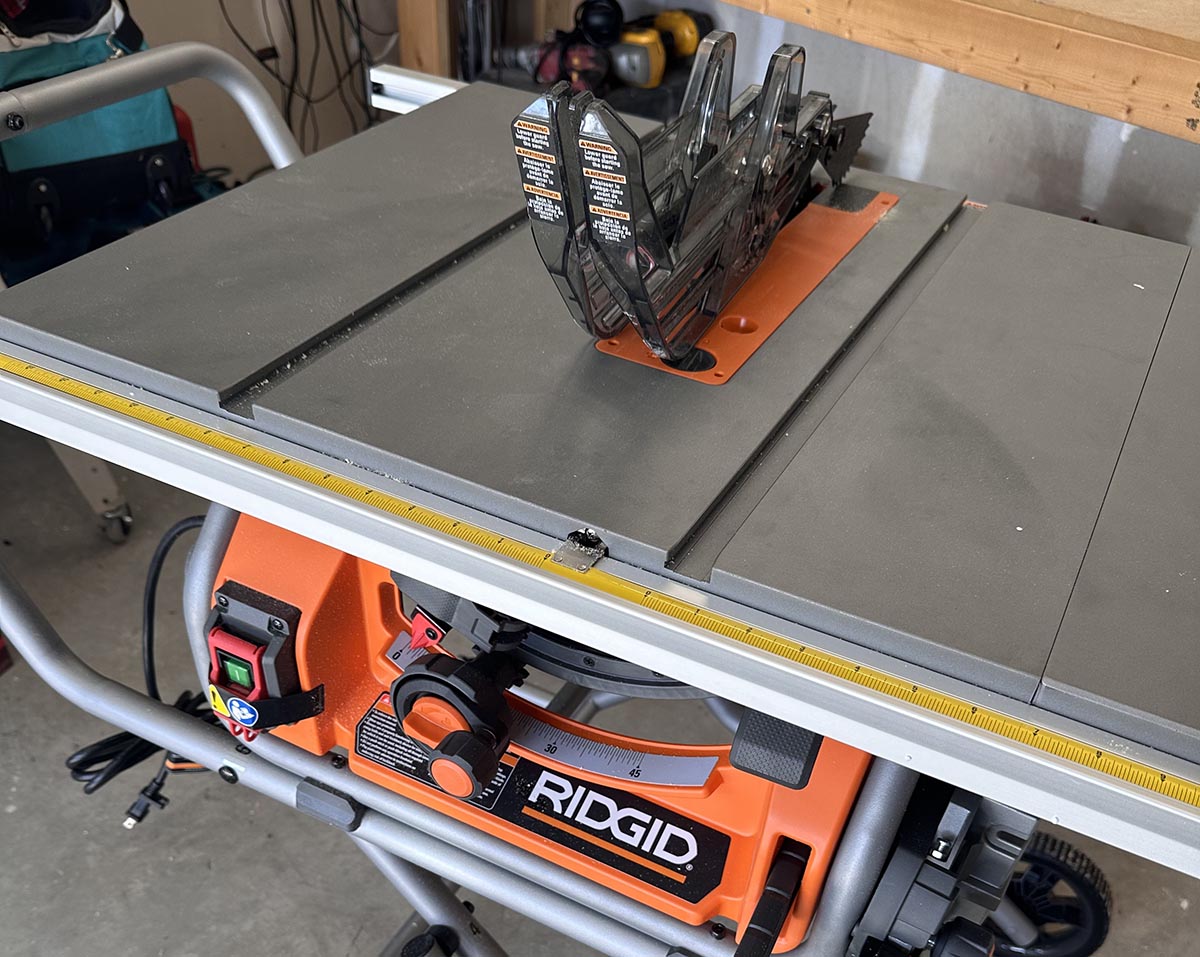
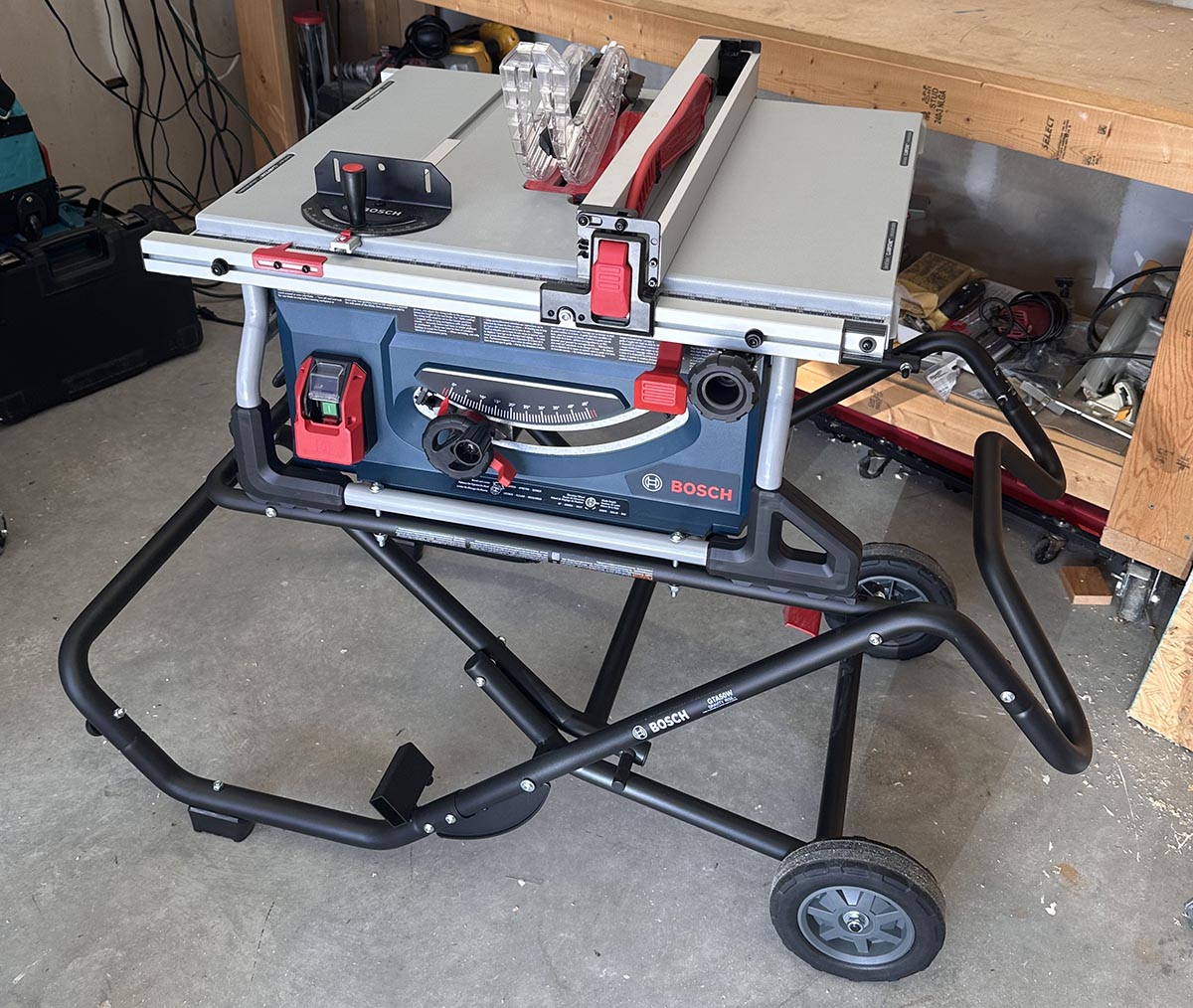

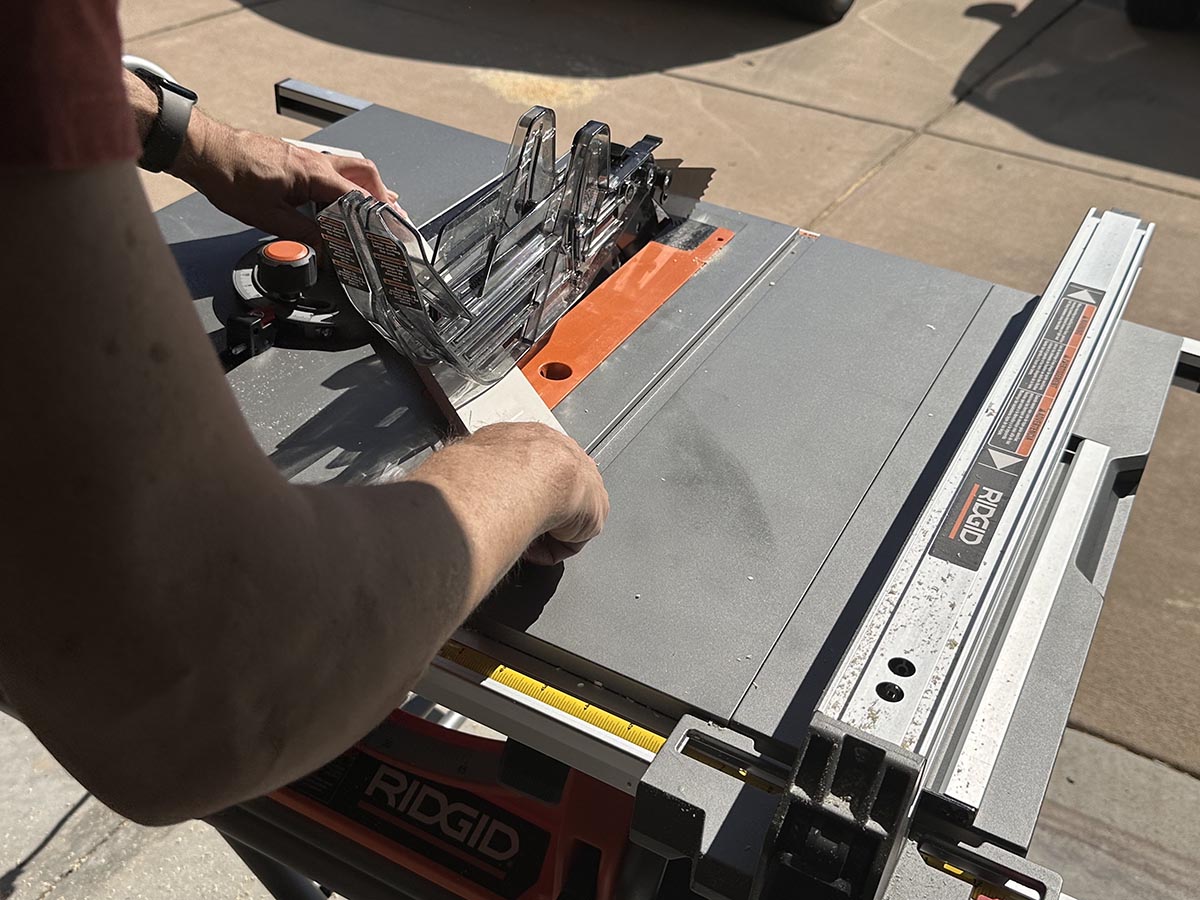
Our Top Picks
There is an enormous breadth of table-saw users, needs, and requirements. Taking as much into account across this spectrum was not easy while evaluating the field of table saws during our hands-on testing. While the following top table saws vary in price, best intended use, and portability, each one earned a spot on this lineup based on its performance, power, and accuracy. One is certain to be right for your cutting needs.
Best Overall
DeWalt 10-Inch Jobsite Table Saw and Rolling Stand
What We Like
- Sturdy, flared legs for added stability
- Included blade is suitable for basic cuts
- Comes with push-stick, miter gauge, and extra riving knife store
- Folds vertically for space-saving storing
What We Don’t Like
- Can wobble at maximum extension
- Heavy; 2-person job to move it around
Product Specs
- Type: Benchtop
- Blade size: 10 inches
- Cutting depth: 3.125 inches
- Rip capacity: 32.5 inches
- Weight: 90 pounds
Our Ratings: Ease of Use 4/5; Power 5/5; Accuracy 5/5; Portability 5/5; Value 5/5
The DeWalt 10-inch table saw is a standout tool in the world of woodworking. With a 15-amp motor, it easily powered through various sheet materials and dimensional lumber in our tests. The saw’s ample 32.5-inch rip capacity allowed us to rip large plywood sheets, and the best part is that this heavy duty saw is still portable—a testament to DeWalt’s ingenuity.
This table saw made smooth, square, and accurate cuts right out of the box—we didn’t have to make any fence adjustments. It has well-placed controls for easy access, including the on/off switch, depth adjustment, bevel adjustment, and fence adjustment.
Assembly was time-consuming (about 45 minutes) because the stand does not come preassembled. However, the outward flared-leg design increases the saw’s stability—a big plus—and was well worth the extra assembly effort. The saw comes with a 24-tooth combo blade, suitable for basic cuts.
Safety features include a shark-fin-style riving knife, blade-guard system, flip-cover power button, and an included push stick. These are basic to virtually all of today’s table saws, and DeWalt has improved their usefulness so they do not hinder precise cuts. The blade guards are still slightly cumbersome, but they’re as good as any of the models we tested.
The decision to buy the DeWalt 10-inch table saw depends on your woodworking needs. It’s ideal for professionals and enthusiasts seeking power, precision, stability, and portability. Its trustworthiness, out-of-the-box performance, and robust construction make it perfect for those aiming for top-tier results.
What our tester says: “I tested several high-quality portable table saws on the jobsite and in my workshop—ripping sheets of plywood and making crosscuts, beveled cuts, and angled cuts. The DeWalt 10-inch saw emerged as a standout. It’s pretty darn close to perfect.” — Glenda Taylor, Product Reviews tester and writer
Read our full review: DeWalt 10-Inch Jobsite Table Saw and Rolling Stand
Get the DeWalt table saw at Lowe’s, Ace Hardware, The Home Depot, or Acme Tools.
Best Bang for the Buck
Ryobi 18V ONE+ HP Brushless 8¼-Inch Table Saw
What We Like
- Cordless unit; doesn’t need to be near a power socket
- Great for beginners and for occasional use
- This table saw is powerful enough to handle most DIY projects
What We Don’t Like
- Not intended for heavy-duty professional use
- Stand not included
Product Specs
- Type: Benchtop
- Blade size: 8.25 inches
- Cutting depth: 2.25 inches
- Rip capacity: 12 inches
- Weight: 32.8 pounds
Our Ratings: Ease of Use 4/5; Power 4/5; Accuracy 4.5/5; Portability 5/5; Value 5/5
The battery on this affordable table saw is fine for light work. The fence was square and parallel out of the box. It’s hardly plush, but it works. The saw is light and portable and has a decent amount of power. It’s not a beast, but it will rip sheet materials up to 12 inches wide and make crosscuts on dimensional lumber. This compact saw is available as a kit with a 4-amp-hour (Ah) battery and charger included, or you can purchase it as a tool only if you already have other 18-volt Ryobi tools, as the batteries interchange.
DIYers and some pros might find its bare-bones setup and low cost just what they need to cut materials for small projects. Being battery-powered is a huge plus, as it allows you to take the saw to remote locations where there is no access to an electrical outlet. It comes with blade guards, a sliding fence, and an 8.25-inch all-purpose blade for making basic cuts.
In our hands-on tests, the Ryobi table saw handled 1x8s and composite decking just fine in terms of power, but it did have trouble ejecting the shavings. Having a blower on hand would be an added help. It features a dust port connection on the back side, which can be connected to a hose from a wet/dry shop-type vacuum to help reduce the amount of sawdust that becomes airborne. There’s no huge stand, but it comes with bolt-down legs so it can be attached to a workbench or work table with screws for added stability during use.
Get the Ryobi table saw at The Home Depot.
Best Upgrade
Bosch 10-Inch Worksite Table Saw w/ Wheeled Stand
What We Like
- Cuts quickly through thicker materials
- Easy to use collapsible stand
- Great rip capacity
- Quality blade height, fence, and miter adjustment mechanisms
What We Don’t Like
- Small miter gauge
Product Specs
- Type: Contractor
- Blade size: 10 inches
- Cutting depth: 3.56 inches
- Rip capacity: 32.125 inches
- Weight: 91 pounds
Our Ratings: Ease of Use 4.5/5; Power 5/5; Accuracy 4/5; Portability 5/5; Value 4.7/5
Bosch has a reputation for its powerful small motors, so there’s little wonder why this 10-inch portable table saw performs so well. We recorded a 3,500 RPM blade speed with the Bosch, which, though slower than other table saws, hit the sweet spot between power and precision. It didn’t hesitate while ripping through 2×6, yet the blade was still quick enough to produce smooth crosscuts through our pieces of 3/4-inch plywood.
We also liked the size of this machine. The Bosch 10-inch table saw’s rip capacity was among the largest we tested at 32-1/8 inches, which allowed us to cut through wider pieces of plywood.
Making adjustments to set up cuts on the Bosch was also easy thanks to well designed machined parts. Once calibrated, the rack and pinion miter fence made it easy to dial in precise rip cuts by rotating a knob. Setting blade height and making precise miter adjustments to the blade is also an easy process thanks to a blade height adjustment wheel that operates smoothly. We only wish the miter attachment that comes with the Bosch was a little beefier. If you plan on making a lot of miter cuts, we recommend upgrading the Bosch’s stock miter gauge with a better aftermarket option.
Though larger, the Bosch table saw is surprisingly easy to move around. It collapses easily using a single foot pedal. Once collapsed, large wheels and never flat tires made it surprisingly easy to roll around the yard.
Out of the box the Bosch comes mostly assembled, though, as with all the table saws we tested, the stand requires a full assembly, which took us the requisite 45 minutes. It took us another 45 minutes to calibrate the miter settings and rip fence guides. Once together, the Bosch is collapsed and set up using a foot pedal.
What our tester says: “I love how portable the Bosch 10-inch portable table saw is. I can set it up or take it down in seconds and its large never flat wheels make it easy to wheel around my shop.” – Tony Carrick, Product Reviews tester and writer
Get the Bosch 10 inch table saw at Amazon, Lowe’s, and The Home Depot.
Best Cordless
Milwaukee M18 Fuel 8¼-Inch Table Saw w/ One-Key Kit
What We Like
- Cordless design provides mobility and flexibility on jobsites
- Minimal assembly time required
- Smooth and accurate cuts on a variety of materials
- Equipped with a dust port
What We Don’t Like
- Relatively small rip capacity is more suitable for smaller projects
Product Specs
- Type: Bench
- Blade size: 8.25 inches
- Cutting depth: 2.5 inches
- Rip capacity: 24.5 inches
- Weight: 41.6 pounds
Our Ratings: Ease of Use 5/5; Power 5/5; Accuracy 4/5; Portability 5/5; Value 4/5
Milwaukee’s 8¼-inch table saw offers cordless convenience, making it suitable for remote usage. This saw is a good combination of power and portability. It comes with a lithium-ion rechargeable 12Ah battery and a rapid charger.
The blade on the M18 cordless table saw was square with the fence right out of the box, and we didn’t need to make any adjustments, which was nice. The motor operated with minimal vibration, and the saw made relatively smooth, clean rips and cuts on ply materials and dimensional lumber using the all-purpose blade in the box.
Assembly was a breeze, taking about 10 minutes to set up the blade, riving knives, and blade guards. The push stick and an extra riving knife are stored within easy reach on the saw body, and all the controls are located near one another on the front. We connected the saw’s dust port to a wet/dry vacuum, which significantly reduced airborne sawdust.
The included miter gauge does the job but may not be suitable for extensive angle cutting. Consider investing in a better miter gauge if you require precision in angle cuts. This table saw offers a maximum bevel up to 47 degrees and a 2.5-inch depth of cut.
The M18 offers one aspect we really wanted to like—and we did, sort of— the One-Key smart module. This built-in tracking device connects via Bluetooth to a smartphone. However, the feature only works when the smartphone is within 100 feet of the saw. Power tool theft is rampant, and we hoped the tracker could be detected within a few miles—100 feet isn’t far enough. But it’s a great start, and we look forward to more innovative solutions from Milwaukee.
Get the Milwaukee table saw at Ace Hardware, The Home Depot, or Acme Tools.
Best for Home Workshop
Skil 10-Inch Jobsite Table Saw
What We Like
- Compact size and lightweight
- Surprisingly powerful
- Retractable legs create stable base
What We Don’t Like
- Small rip capacity
Product Specs
- Type: Bench
- Blade size: 10 inches
- Cutting depth: 3.5 inches
- Rip capacity: 25.5 inches
- Weight: 51.2 pounds
Our Ratings: Ease of Use 4.25/5; Power 4/5; Accuracy 4/5; Portability 5/5; Value 4.7/5
Compact yet surprisingly powerful, Skil’s table saw is an excellent pick for those with limited space in their workshop or who may not be able to justify spending a lot on a table saw. Given its low price, we were pleasantly surprised by the amount of power this table saw produces. With its 15 amp motor, it capably reached speeds of more than 4,200 RPM, allowing it to make smooth cuts on thinner pieces of plywood.
Despite that higher speed, it still packed enough torque to still handle thicker stock with relative ease. We also like the rack and pinion fence rails that make it easier to set up rip cuts, a feature typically found on pricier table saws.
The Skill is the smallest of our tested table saws with a rip capacity of just 25.5 inches. While that may mean you’ll need to turn to your circular saw if taking on larger pieces of plywood, it also makes the Skil much more compact, measuring just 2 feet by 2 feet. And unlike the other portable table saws we tested, the Skil sits on foldable legs as opposed to a collapsible base. While this meant it was a little harder to set up and break down, it also made for a much more compact table saw for storage.
And while it lacks the wheels of the other table saws we test, at just 51 lbs. it was easy to lift and move around the workshop. And yet, thanks to legs that create a broad base, it had less wiggle than any other table saw we tested.
Get the Skil 10-inch jobsite table saw at Lowe’s, Walmart, or Acme Tools.
Best Compact
Skil 8¼-Inch Portable Worm Drive Table Saw
What We Like
- Smooth power; a true pleasure to use
- Portable, compact, and easy to move
- Has a fantastic cord, fence, and up-front locking mechanism
What We Don’t Like
- Requires stand
Product Specs
- Type: Benchtop
- Blade size: 8.25 inches
- Cutting depth: 2.625 inches
- Rip capacity: 25 inches
- Weight: 44 pounds
Our Ratings: Ease of Use 4/5; Power 4/5; Accuracy 4/5; Portability 5/5; Value 4/5
This table saw from Skil, a scaled-down version of its 10-inch cousin, is a pleasure to use. The 8.25-inch platform cuts the vast majority of things table saws cut. The worm drive motor, which is plush to be sure but also a bit heavy, isn’t bad in this smaller platform tool. This Skil table saw cuts like any other table saw—it qualifies as a worm drive thanks to the configuration of the motor, which is aligned at a 90-degree angle to the blade shaft. The saw is compact, easy to move, and is so pleasantly quiet at start-up that it’s a joy to use.
Combined with an outstanding fence and up-front locking mechanism, this saw can move from site to site, around the garage, or to a stationary place for long projects and still deliver dependable performance. It weighs in at 44 pounds and features a steel carry handle on the side for moving.
While the saw did not ship with a stand, the roll cage is bored for a stand, or for bolting it down to a workbench when added stability is needed. The compact design is also great for loading the saw on a work truck. It comes with an all-purpose blade that should be suitable for basic cutting needs. However, if you’re looking to cut trim or finish work, consider upgrading to a finer-tooth blade.
Get the Skil table saw at Amazon, Lowe’s, The Home Depot, Walmart, or Acme Tools.
Best Safety Stop
SawStop Compact Table Saw
What We Like
- Precise alignment and 90-degree blade angle right out of the box
- Capable of cleanly cutting plywood, softwood, and dense materials
- Hassle-free blade changes with included tools and built-in storage
- User-friendly intuitive adjustments for blade angle and alignment
- Skin-contact advanced-safety mechanism
What We Don’t Like
- Considerably loud operation compared to quieter saws
- Initial testing did not reliably trigger the safety brake
- Pricey saw compared to others we tested
Product Specs
- Type: Bench-type
- Blade size: 10 inches
- Cutting depth: 3.125 inches
- Rip capacity: 24.5 inches
- Weight: 68 pounds
Our Ratings: Ease of Use 4.5/5; Power 5/5; Accuracy 4/5; Portability 5/5; Value 5/5
The SawStop 10-inch table saw offers a unique blend of precision woodworking and advanced safety features to protect users from potentially catastrophic accidents. Testing the safety mechanism proved to be more complicated than we expected but led us to a greater understanding of the technology behind the best safety stop.
Setting up the SawStop was a breeze, with straightforward assembly and quick readiness for cutting tasks. Straight out of the box, the saw impressed with its exceptional accuracy, aligning perfectly and maintaining a precise 90-degree blade angle.
While the saw delivers stable performance, it exhibited more hopping or chattering than desired when tackling dense materials like hardwood and composite decking. Still, it produced clean cuts with minimal splintering. It ripped plywood and softwood very well.
Blade changes are hassle-free thanks to the included tools and the built-in tool and accessory storage system. Adjusting the saw’s settings, whether blade angle or alignment, is intuitive and accurate, which simplifies the overall woodworking process.
One slightly disappointing aspect was the saw’s noise level, as it can be considerably loud, particularly compared to quieter models available on the market.
The standout feature of the SawStop is its safety mechanism, which is designed to stop the blade upon contact with skin, potentially preventing severe injuries. In our testing, we attempted to trigger this safety brake using chicken wings and large breakfast sausages. Surprisingly, the safety mechanism did not activate with these test materials, leading to concerns about its reliability.
We consulted a SawStop engineer, who explained that the safety brake requires greater electrical conductivity to trigger reliably. This information provides a more nuanced perspective on the safety system’s functionality. While our initial tests failed, it’s essential to acknowledge that the system may respond differently to variations in conductivity.
Overall, the SawStop 10-inch table saw impressed us with its precision and woodworking capabilities. While potentially effective under specific conditions, its safety mechanism may require a deeper understanding of its functionality. If the safety feature can be consistently trusted, the SawStop offers significant value for users prioritizing safety in their woodworking endeavors.
Get the SawStop table saw at The Home Depot, Acme Tools, or The Tool Nut.
Best Portable
Ridgid 10-Inch Portable Corded Pro Jobsite Table Saw
What We Like
- Ample cutting power and speed
- Easy to collapse and move
- Large rip capacity
What We Don’t Like
- No rack and pinion fence controls
Product Specs
- Type: Contractor
- Blade size: 10 inches
- Cutting depth: 3.5 inches
- Rip capacity: 30 inches
- Weight: 95 pounds
Our Ratings: Ease of Use 4.5/5; Power 4/5; Accuracy 4/5; Portability 5/5; Value 4/5
Ridgid’s table saw packs ample power in a portable design with its 10-inch jobsite table saw. We loved the precision cutting that Ridgid brings with this table saw. It registered the highest blade speed of any we tested, topping out at a whopping 4,800 RPM. We were able to make clean precise cuts through 3/4-inch plywood while still making quick work of thicker dimensional lumber. The Ridgid also has one of the larger rip capacities of any table saw we tested at 30 inches.
Setting up cuts on the table saw is relatively easy. The blade height adjustment knob operates smoothly and adjusting miter angle is relatively easy. Ridgid’s miter gauge is also better quality than most of the other table saws we tested. Our only gripe was with the rip fence, which doesn’t have a rack and pinion adjustment, which makes it harder to set up cuts and keep the fence square to the blade.
Ridgid’s job site saw comes with a wheeled base, which requires assembly out of the box, a process that took about 45 minutes. Once together, the base is easy to collapse and raise using a single foot operated locking mechanism. And once collapsed, wheeling this 95-lb. table saw around is surprisingly easy.
Get the Ridgid 10-inch portable table saw at The Home Depot.
Best Rip Capacity
Metabo HPT 10-Inch Table Saw With Fold and Roll Stand
What We Like
- Large rip capacity
- Legs create a Sturdy base
- Extendable support for stock
What We Don’t Like
- Low quality miter gauge
- Doesn’t cut thicker stock easily
Product Specs
- Type: Contractor
- Blade size: 10 inches
- Cutting depth: 3.125 inches
- Rip capacity: 35 inches
- Weight: 96 pounds
Our Ratings: Ease of Use 4/5; Power 3.5/5; Accuracy 4.5/5; Portability 4/5; Value 4/5
Metabo’s table saw offers a different take on the portable table saw design with excellent rip capacity and some thoughtful features not found on other table saws we tested. The Metabo 10-inch table saw’s performance was good, though not exceptional. It made clean cuts through 3/4-inch plywood. And while it was able to rip through a 2×6, it did so at a slower pace than other table saws we tested. We also wish the cutting depth was a little greater. At 3.125 inches, the Metabo table saw can’t quite cut through a 4×4.
Metabo comes equipped with a rack and pinion fence adjuster, which made it easy to set up rip cuts, and we also liked the whopping 35-inches of rip capacity. There’s also a retractable support that extends off the back of the table saw to support stock as it’s coming off the blade, a very useful feature we didn’t find on any other table saws we tested.
A common complaint with portable table saws is their low-quality miter gauges and the Metabo’s undersized miter gauge was no exception. If you want to make precise miter cuts, you’ll need to look for an aftermarket option.
Metabo has legs that fold up individually under the saw, which is different from the foldable carriages that other saws have. While this made for a sturdy base when set up, we found set up and take down to be a more challenging process. It’s also more difficult to adjust the saw’s position once set up than those equipped with wheels.
Get the Metabo portable 10-inch table saw at Lowe’s or Acme Tools.
Jump to Our Top Picks
How We Tested the Best Table Saws
In choosing the table saws we wanted to test, we researched more than 25 popular models—making note of the following aspects:
- Capacities. Most table saws are 10-inch models, and specifications are very similar. While their primary function in home workshops and on jobsites is ripping dimensional lumber—which doesn’t require a huge rip capacity—ripping capacity varies tremendously and is a key feature for those who cut large sheet material. We were careful to source solutions for all types of users.
- Size and portability. For many users, a compact, portable table saw is the ideal solution. For others, physical size is less important than capacity and stability. Our comprehensive selection includes saws that are great for those who work with these tools on-site or in small spaces at home or in a large workshop.
- Brand and value. We avoided cheap table saws, which are often poor in terms of durability and reliability. While buying from the leading table saw brands can mean you pay a little more, this almost always results in better long-term value.
In our testing process, we thoroughly examined each saw’s performance using a comprehensive rubric—the better a saw performed a test, the more points we awarded. We assessed each saw’s power and ability to rip and cut a variety of materials, including ply-type sheet materials and dimensional lumber.
We also evaluated the included stands, switches, and adjustments. We considered the overall feel of using the tool for everything from weekend work around the house to building a deck or shed to a months-long setup for remodeling a house.
| Ease of Use | Power | Accuracy | Portability | Value | |
| DeWalt 10-Inch Jobsite Table Saw and Rolling Stand | 4/5 | 5/5 | 5/5 | 5/5 | 5/5 |
| Ryobi 18V ONE+ HP Brushless 8¼-Inch Table Saw | 4/5 | 4/5 | 4.5/5 | 5/5 | 5/5 |
| Bosch 10-Inch Worksite Table Saw w/ Wheeled Stand | 4.5/5 | 5/5 | 4/5 | 5/5 | 4.7/5 |
| Milwaukee M18 Fuel 8¼-Inch Table Saw w/ One-Key Kit | 5/5 | 5/5 | 4/5 | 5/5 | 4/5 |
| Skil 10-Inch Jobsite Table Saw | 4.3/5 | 4/5 | 4/5 | 5/5 | 4.7/5 |
| Skil 8¼-Inch Portable Worm Drive Table Saw | 4/5 | 4/5 | 4/5 | 5/5 | 4/5 |
| SawStop Compact Table Saw | 4.5/5 | 5/5 | 4/5 | 5/5 | 5/5 |
| Ridgid 10-Inch Portable Corded Pro Jobsite Table Saw | 4.5/5 | 4/5 | 4/5 | 5/5 | 4/5 |
| Metabo HPT 10-Inch Table Saw With Fold and Roll Stand | 4/5 | 3.5/5 | 4.5/5 | 4/5 | 4/5 |
| Testing Stats | |
| Products tested | 9 |
| Time spend testing | 10 hours |
| Tests performed | 6 |
| Price range | $300 to $650 |
What to Consider When Choosing a Table Saw
Table saws run the gamut in quality and price, so consider the guidance below when shopping for the best table saws.
Types of Table Saws
While all table saws function in a similar manner—a flat tabletop surface supports the material being cut as you manually feed it into the saw blade—they differ in design, power, best use, mobility, and storage.
Bench Saws
Designed to be bolted to a workbench or attached to a stand, a benchtop table saw is compact and relatively lightweight, averaging 45 to 70 pounds (not including some stands). While some benchtop table saws have the cut capacity for cutting sheet goods, they are not really designed for this without modifications like infeed/outfeed support tables, usually shop built.
It’s possible to cut sheet material from time to time alone (better if there is a helper), but these saws are generally considered too compact and not quite stable enough for ripping something like 0.75-inch medium-density fiberboard (MDF); sheet materials, such as plywood and OSB; or plastic and aluminum paneling. For planks, deck boards, 2-by material, and the like, these tools are often indispensable.
Benchtop saws, which can cost $600 or more, are more affordable than larger contractor or cabinet table saws. But since they’re the smallest type of table saw, these tools are limited by the width of the material they can cut—usually about 18 to 20 inches (see “Rip Capacity” below).
Contractor Saws
A contractor table saw is designed to be somewhat mobile in a shop setting by utilizing a wheel kit. While some contractors use these types of saws on jobsites, the tools are often set up in a workshop for months on end. These jobsite table saws are also good for serious DIYers who have a semipermanent place for them and are doing a variety of tasks that require cast-iron stability and more horsepower than a benchtop saw.
They’re heavier than bench saws (90 to 150 pounds) and are generally capable of cutting sheet material up to 24 inches wide or wider. These tools can run as much as $1,500 or more, depending on quality and power.
Cabinet Saws
Packing more power than other table saws and sometimes requiring a 220-volt circuit, cabinet saws are large stationary table saws. These are the priciest options, ranging from $1,200 to $5,000 or more, depending on power and quality. The motor is fully enclosed in a cabinet below the table.
Cabinet saw users also often build support tables for these tools—called infeed and outfeed support—to make it easier to manage sheet goods like MDF, plywood, and heavier material. Often found in professional or industrial workshops and in trade schools, these heavy saws can weigh more than 600 pounds.
Hybrid Saws
The hybrid table saw is a combination of the cabinet and contractor types. It offers at least as much power as a contractor saw, but without requiring a dedicated 220-volt circuit. Expect to pay $750 to $1,500 for hybrid table saws, which are sometimes described as souped-up contractor saws.
Hybrid saws come with enclosed cabinets, mimicking the look of cabinet saws, but they weigh less, averaging 275 to 325 pounds. They’re usually moved with a hand truck, but wheel kits are often available for them as well.
Power
In short, the more horsepower (hp) in a table saw motor, the more cutting power the saw has. Smaller benchtop saws that typically feature horsepower in the range of 0.75 to 1.5 hp are sufficient for most things a larger table saw can cut; however, they may not leave quite as smooth a cut as a contractor or cabinet saw. Be aware that these ratings are typically shown in “amps” (e.g., 15 amps) and refer to how many amperes the tool draws. Benchtop tools are regular jobsite and workshop occupants, sizing everything from shelving to hardwoods for a woodworking project and to pressure-treated lumber for backyard projects.
Larger bench saws and contractor saws come with 2- to 4-hp motors, and cabinet table saws often feature 5-hp or larger motors. The more powerful motors run longer under heavy use without overheating (think cabinet shop where they’re used every day, all day, for years on end) and easily cut through denser materials, such as ironwood or Brazilian walnut.
Cutting Depth and Blade Size
Table saws are labeled by the size of the circular blade they accommodate; the vast majority take 10-inch blades, while a handful take 8.25-inch blades and a few take 12-inch blades. The blade height and angles are adjustable, so it can make a shallow cut just a fraction of an inch deep as well as deeper cuts. The newest generation of table saws—many cordless or corded/cordless—spin a 7.5-inch blade, similar to that on a circular saw.
With a 10-inch table saw, you can often make a maximum cut up to 3.5 inches deep (that enables you to rip a 4×4 in half).
Fence
The fence on a table saw is the adjustable guide that holds the material in place while cutting. There are two fence styles that come with most table saws: one is a T-square fence, which is in all categories of table saws and built with varying degrees of quality based on the saw’s intended use. The other type of fence is a rack-and-pinion-style fence, which is found primarily in the benchtop category.
Some saws also come with extendable fences that either fold or slide out to accommodate larger sections of wood. Other table saws feature fences with embedded magnifiers that allow you to better see the measurements on the saw when adjusting the fence. However, many users simply rely on a tape measure. By measuring from the fence to the tip of a blade tooth, the accuracy (or not) of the fence’s pointer doesn’t need to be depended upon or interpreted.
Rip Capacity
Table saws are key to ripping wide sheets of material, but the maximum width of material that will fit between the saw blade and the fence—the rip capacity—varies. Rip capacity starts at around 18 inches for entry-level benchtop saws and runs up to 60 inches or more for professional cabinet saws.
Depending on the planned projects, choose a table saw with a rip capacity large enough to accommodate the dimension of the material. For example, if the goal is to build 2-foot-high toy boxes, a saw with a rip capacity of at least 24 inches can cut sections of plywood wide enough for the sides and back.
On the other hand, many pros use track saws for this purpose. Whether it’s cutting down a door to accommodate new flooring or sizing sheet stock for building a bench, track saws are light and accurate.
Dust Collection
If you’re working in a closed workshop, dust-collection ports will help keep the air dust-free and collect sawdust chips that would otherwise have to be swept up later. Table saws have dust-collection ports designed to connect to a standard shop vacuum. Users will want to run the workshop vacuum while operating the saw to catch dust and sawdust.
For cutting synthetic material outdoors, such as composite decking or PVC trim, it’s a good idea to put a box or bucket under the saw to catch the shavings if the saw is set up on the grass. Standing on a large sheet of cardboard or a drop cloth also helps. Once those shavings get in the grass, they’re nearly impossible to get out.
Tips for Using a Table Saw
Owners will doubtless spend many hours learning how to get the best from their table saw. The following quick tips provide a useful place to start:
- Read the manual carefully even if you have owned a table saw before; there will often be differences. It’s important to understand the safety features and know how to maximize performance.
- By law, all table saws must have a blade guard. Never operate the saw without it in place. The riving knife should only be removed if using a dado blade.
- Always wear eye protection. Ear defenders are also a good idea.
- Check the blade for damage before each work session. If there is a crack, missing teeth, or unexpected vibration, replace the blade immediately.
- There’s an old woodworking adage that you should measure twice and cut once. This can also apply to setting up a table saw. Adjust and then check before making each cut.
- Clean the table saw after use. Disconnect the power first, then use an ordinary nylon-bristle hand brush or cordless blower.
- Learning how to make featherboards, push sticks, and table saw jigs can improve safety, speed, and accuracy, particularly with repetitive tasks. It’s also very rewarding to make things yourself rather than buying them.
- Blade choice can have a dramatic impact on performance, even if the diameter remains the same. You can read more about the best table saw blades in a separate article.
FAQs
Apart from protective goggles or safety glasses and a stand of some sort, everything you need should come with the saw. In addition to providing some basic tips for using the table saw above, there is a more in-depth beginner’s guide here.
A few 10-inch table saws will cut a 4×4 in a single pass, but not many. Bear in mind that 4×4 refers to dimensioned lumber that is actually closer to 3.5 inches square. A common maximum for 10-inch table saws is 3.125 inches, though the cut can usually be completed by turning the material over and running it through the saw again.
It might be possible, but it is not recommended. Miter saw bases are fixed differently, so the result would probably be unsafe.
A sturdy bench can work, and it isn’t difficult to find plans for DIY table saw stands. You could also consider investing in a purpose-built stand.
You should usually stand behind the saw table and to the left of the blade. Make sure you are comfortable and not stretching. If working with large sheet material, it’s a good idea to have someone support it on the out-feed side.
Meet the Testers
Tony Carrick is a freelance writer specializing in home improvement, landscaping, technology, home security, and design. Carrick has conducted rigorous product testing on everything from power tools to home security systems to backyard grills. With each review, his goal is to help readers determine whether a product meets their needs and if it is or isn’t worth its price tag.
Mark Clement is a carpenter and professional remodeler who loves telling stories about tools and how-to’s in any way he can. With his wife, Theresa Clement, he helped develop the blog MyFixitUpLife, opening the way to other home improvement adventures
Corey Foster has been woodworking and metalworking since the moment his grandmother entrusted him with workspace, hand tools, and a pile of scrap wood. If he’s not solving a problem with a tool, Corey is likely teaching a STEAM class or spending time with family.
Glenda Taylor is a product tester and writer specializing in the construction, remodeling, and real estate industries. She tests a wide range of power tools as well as other home improvement, household, and lawn-and-garden products.
Additional research provided by Mark Clement and Bob Beacham.



